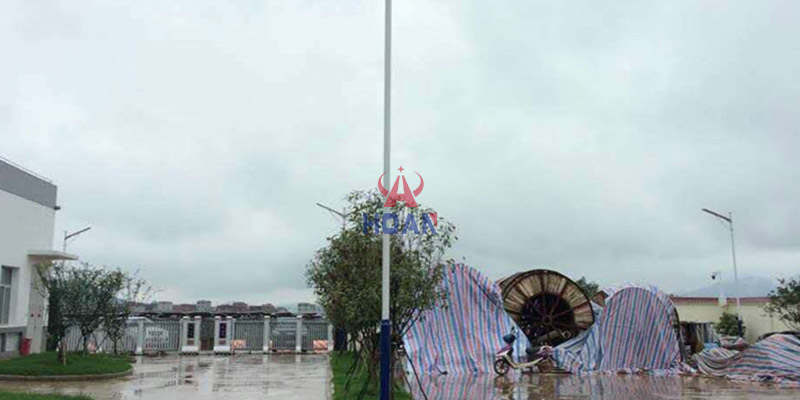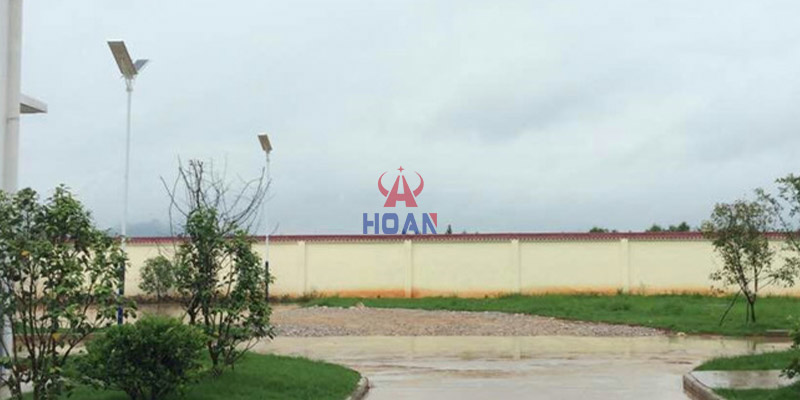As a sustainable lighting solution for urban and rural areas, solar-powered LED streetlights are gradually becoming the mainstream choice for road lighting due to their energy-efficient and environmentally friendly features. Powered by solar energy, they can not only significantly reduce carbon emissions, but also save 60%-80% of the traditional lighting electricity costs for cities and villages, and at the same time improve road safety at night through high-brightness LED light source, reducing the incidence of traffic accidents.
Solar energy conversion process
The core of solar LED street light is photovoltaic effect:
Light energy capture: monocrystalline silicon / polycrystalline silicon solar panels with high conversion efficiency (usually 18%-22% efficiency) convert photons into electrons under the light, generating DC current.
Energy regulation: The charge controller regulates the current in real time to avoid overcharging and damaging the battery, and cuts off the discharge circuit to protect the energy storage system when there is insufficient light.
Energy storage and lighting mechanism
Battery energy storage: lithium-ion batteries (life span of 5-10 years) or lead-acid batteries (life span of 3-5 years) to store electricity, the typical configuration of the average daily 4-6 hours of charging can support 10-12 hours of night lighting.
LED light-emitting: the DC power from the battery is converted to AC power by inverter to drive the LED lights at night, and the luminous efficacy can reach 150-200 lumens/watt, which is more than 70% energy-saving than the traditional high-pressure sodium lamps.

IP protection level standard
IP level is the core indicator of waterproof and dustproof ability:
IP65: anti-jet water (no damage from spraying water in any direction), suitable for medium rain environment.
IP67: Protected against short-term immersion (1 metre water depth for 30 minutes), suitable for rainy areas.
IP68: anti-long-term immersion (usually 1-3 metres of water depth), suitable for high humidity or waterlogged areas.
Structural and Material Innovations
Sealing Design: Silicone sealing ring + ultrasonic welding process to ensure seamless connection between the light body and the base, such as a brand of LED street light through the 10kPa air pressure waterproof test, equivalent to withstand the pressure of 1 metre water depth.
Weather-resistant materials: aviation-grade aluminium alloy shell (surface anodic oxidation treatment) can resist salt spray corrosion (1000 hours of testing without rust), PC lampshade anti-UV aging (5 years yellowing index <5).
Drainage system: Concealed drainage holes are set at the bottom of the lamp body to ensure quick discharge when rainwater accumulates and avoid internal water accumulation.
Fluctuation of solar panel efficiency
Under continuous rainy weather, the power generation of solar panels will drop significantly:
Sunny vs. rainy days: the light intensity drops from 1000W/m² (sunny days) to 100-200W/m² (moderate rain), and the power generation is reduced by 60%-80%.
Challenge of energy storage: If lead-acid batteries are equipped, 3 consecutive days of rain may cause the power to fall below 50%, triggering the under-voltage protection; lithium-ion batteries, due to their high energy density, can maintain more than 65% of the remaining power under the same conditions.
Potential Risks and Failures
Mechanical Damage: Debris carried by rainstorms may hit the lampshade or solar panels, resulting in rupture (probability of about 0.5%-1%).
Electrical failures: Failure of the waterproof seal may lead to short circuits, manifested by flickering or non-lighting of LEDs (30%-40% of failures during the rainy season).
Battery degradation: Prolonged high humidity accelerates battery self-discharge, with lead-acid battery self-discharge rates rising from 3% to 5-8% per month.
Standardised installation points
Foundation design: C25 concrete base, height above ground 10-15cm, to avoid water soaking the lamp body.
Grounding protection: grounding resistance <4Ω, to prevent the risk of lightning strikes or leakage, especially in the lightning area need to be installed surge protector.
Cyclical maintenance programme
| Maintenance Project | Frequency of rainy season | Operation points |
| Solar Panel Cleaning | Every 2 weeks | Use a soft cloth + neutral detergent to remove bird droppings and gum, and ensure that the light transmittance is greater than 95%. |
| Leakage inspection | per month | Observe whether the sealing ring is aging or cracking, replace the failed parts, and reapply waterproof glue |
| Battery voltage detection | per month | The voltage of lithium-ion batteries should be ≥3.6V, and that of lead-acid batteries should be ≥12.6V. If the voltage is below the threshold, it needs to be charged or replaced in time. |
| Drain hole dredging | Quarterly | Remove sediment and fallen leaves to ensure smooth drainage |
Product technology upgrade
Self-cleaning coating: Nano titanium dioxide coating makes rainwater form rolling balls on the surface of the board, taking away more than 90% of dust and reducing the frequency of manual cleaning.
Intelligent light control system: Built-in ambient light sensor automatically adjusts the LED power from 60W to 40W in rainy days, extending the operating time by more than 30%.
Hybrid power supply programme: in rainy areas with a small wind turbine, forming a ‘solar + wind’ complementary system to ensure continuous rainy day lighting without worry.

Successful Application Scenarios
Tropical Rainforest in Southeast Asia: Kuala Lumpur, Malaysia, installed 5000 IP68-rated solar LED streetlights in 2022, and experienced 2500mm rainfall throughout the year (daily average of 7mm), and the lamps and lanterns had an intact rate of 98.7%, with only 3 failing due to clogged drain holes, and were restored to normal after maintenance.
Coastal cities in southern China: Zhuhai City, a coastal road using ‘solar + lithium battery + intelligent control’ programme, in the typhoon season (instantaneous rainfall of up to 150mm / h) is still running stably, the LED brightness has not been significantly affected.
Failure Improvement Experience
A county road was installed with IP65 street lights at the beginning, and the failure rate was as high as 15% during the rainy season, mainly due to the following reasons:
Installation defects: the base was lower than the road surface, which led to the backflow of stagnant water;
Maintenance deficiencies: the solar panels were not cleaned up in time, and the power generation efficiency dropped to 50% of the design value;
Improvement measures: upgrading the IP level to IP67, elevating the base and increasing the slope of the water drainage, and setting up monthly maintenance system, and the subsequent failure rate dropped to 3%. Improvement measures: Upgrade the IP rating to IP67, raise the base and increase the drainage slope, establish a monthly maintenance system, and reduce the subsequent failure rate to below 3 per cent.
Solar LED streetlights are fully capable of working normally in the rainy season, provided that:
choose products with IP67 or higher protection level and match with weather-resistant lithium-ion batteries;
ensure standardised installation (higher than the ground, reliable grounding) and regular maintenance (cleaning, draining, sealing inspection);
give priority to self-cleaning, intelligent dimming and other upgraded functions in rainy areas, so as to improve the redundancy of the system.
For municipal purchasers, it is recommended to clearly require in the bidding documents:
IP rating of lamps ≥ IP67, battery capacity designed for 5 consecutive days of cloudy rain;
suppliers to provide 3 years of free maintenance services, including special testing before the rainy season;
remote monitoring system installed in the pilot area, real-time monitoring of the status of the lamps and lanterns, and early warning of failures.
As the core carrier of low-carbon lighting, solar LED streetlights can not only withstand the challenges of the rainy season, but also provide long-term value for sustainable urban development through scientific selection and maintenance. For further product details or customised solutions, please contact our technical team.